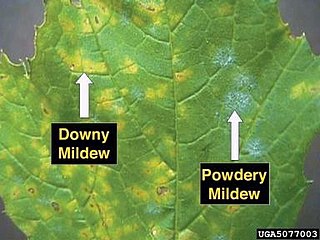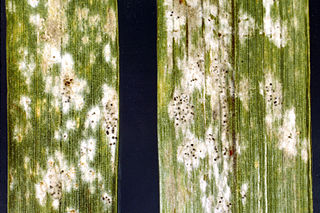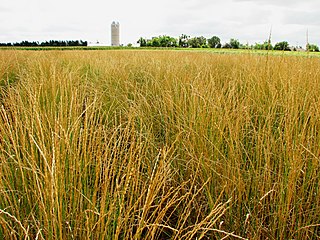Related Research Articles

Wheat is a grass widely cultivated for its seed, a cereal grain that is a staple food around the world. The many species of wheat together make up the genus Triticum ; the most widely grown is common wheat. The archaeological record suggests that wheat was first cultivated in the regions of the Fertile Crescent around 9600 BC. Botanically, the wheat kernel is a caryopsis, a type of fruit.

Powdery mildew is a fungal disease that affects a wide range of plants. Powdery mildew diseases are caused by many different species of ascomycete fungi in the order Erysiphales. Powdery mildew is one of the easier plant diseases to identify, as the signs of the causal pathogen are quite distinctive. Infected plants display white powdery spots on the leaves and stems. This mycelial layer may quickly spread to cover all of the leaves. The lower leaves are the most affected, but the mildew can appear on any above-ground part of the plant. As the disease progresses, the spots get larger and denser as large numbers of asexual spores are formed, and the mildew may spread up and down the length of the plant.

Magnaporthe grisea, also known as rice blast fungus, rice rotten neck, rice seedling blight, blast of rice, oval leaf spot of graminea, pitting disease, ryegrass blast, Johnson spot, neck blast, wheat blast and Imochi (稲熱), is a plant-pathogenic fungus and model organism that causes a serious disease affecting rice. It is now known that M. grisea consists of a cryptic species complex containing at least two biological species that have clear genetic differences and do not interbreed. Complex members isolated from Digitaria have been more narrowly defined as M. grisea. The remaining members of the complex isolated from rice and a variety of other hosts have been renamed Magnaporthe oryzae, within the same M. grisea complex. Confusion on which of these two names to use for the rice blast pathogen remains, as both are now used by different authors.

Blumeria graminis is a fungus that causes powdery mildew on grasses, including cereals. It is the only species in the genus Blumeria. It has also been called Erysiphe graminis and Oidium monilioides or Oidium tritici.
The gene-for-gene relationship is a concept in plant pathology that plants and their diseases each have single genes that interact with each other during an infection. It was proposed by Harold Henry Flor who was working with rust (Melampsora lini) of flax (Linum usitatissimum). Flor showed that the inheritance of both resistance in the host and parasite ability to cause disease is controlled by pairs of matching genes. One is a plant gene called the resistance (R) gene. The other is a parasite gene called the avirulence (Avr) gene. Plants producing a specific R gene product are resistant towards a pathogen that produces the corresponding Avr gene product. Gene-for-gene relationships are a widespread and very important aspect of plant disease resistance. Another example can be seen with Lactuca serriola versus Bremia lactucae.
Leptosphaeria maculans is a fungal pathogen of the phylum Ascomycota that is the causal agent of blackleg disease on Brassica crops. Its genome has been sequenced, and L. maculans is a well-studied model phytopathogenic fungus. Symptoms of blackleg generally include basal stem cankers, small grey lesions on leaves, and root rot. The major yield loss is due to stem canker. The fungus is dispersed by the wind as ascospores or rain splash in the case of the conidia. L. maculans grows best in wet conditions and a temperature range of 5–20 degrees Celsius. Rotation of crops, removal of stubble, application of fungicide, and crop resistance are all used to manage blackleg. The fungus is an important pathogen of Brassica napus (canola) crops.

Zymoseptoria tritici, synonyms Septoria tritici, Mycosphaerella graminicola, is a species of filamentous fungus, an ascomycete in the family Mycosphaerellaceae. It is a wheat plant pathogen causing septoria leaf blotch that is difficult to control due to resistance to multiple fungicides. The pathogen today causes one of the most important diseases of wheat.

Podosphaera macularis is a plant pathogen infecting several hosts including chamomile, caneberrie, strawberries, hop, hemp and Cineraria. It causes powdery mildew of hops.

Podosphaera pannosa is a plant pathogen. It produces a powdery mildew on members of the rose family.
Microbial inoculants, also known as soil inoculants or bioinoculants, are agricultural amendments that use beneficial rhizosphericic or endophytic microbes to promote plant health. Many of the microbes involved form symbiotic relationships with the target crops where both parties benefit (mutualism). While microbial inoculants are applied to improve plant nutrition, they can also be used to promote plant growth by stimulating plant hormone production. Although bacterial and fungal inoculants are common, inoculation with archaea to promote plant growth is being increasingly studied.

Thinopyrum intermedium, known commonly as intermediate wheatgrass, is a sod-forming perennial grass in the Triticeae tribe of Pooideae native to Europe and Western Asia. It is part of a group of plants commonly called wheatgrasses because of the similarity of their seed heads or ears to common wheat. However, wheatgrasses generally are perennial, while wheat is an annual. It has gained the Royal Horticultural Society's Award of Garden Merit as an ornamental.

Plant disease resistance protects plants from pathogens in two ways: by pre-formed structures and chemicals, and by infection-induced responses of the immune system. Relative to a susceptible plant, disease resistance is the reduction of pathogen growth on or in the plant, while the term disease tolerance describes plants that exhibit little disease damage despite substantial pathogen levels. Disease outcome is determined by the three-way interaction of the pathogen, the plant, and the environmental conditions.

Triticum carthlicum Nevski, 1934, the Persian wheat, is a wheat with a tetraploid genome.

Leymus mollis is a species of grass known by the common names American dune grass, American dune wild-rye, sea lyme-grass, strand-wheat, and strand grass. Its Japanese name is hamaninniku. It is native to Asia, where it occurs in Japan, China, Korea, and Russia, and northern parts of North America, where it occurs across Canada and the northern United States, as well as Greenland. It can also be found in Iceland.
Ernest Robert Sears was an American geneticist, botanist, pioneer of plant genetics, and leading expert on wheat cytogenetics. Sears and Sir Ralph Riley (1924–1999) are perhaps the two most important founders of chromosome engineering in plant breeding.
Mildew locus o (MLO) is a plant-specific gene family. Specific members of the Mildew Locus O gene family act as powdery mildew susceptibility factors. Their inactivation, as the result of a loss-of-function mutation, gene knock-out, or knock-down, is associated with a peculiar form of resistance, referred to as mlo resistance. The mlo gene family is widely conserved across the plant kingdom with some members evolving as early as the first land plants. Mlo proteins contain seven highly conserved transmembrane domains, as well as a calmodulin-binding domain. TaMLO genes are the MLOs in bread wheat, Triticum aestivum.
2Blades is an agricultural phytopathology non-profit which performs research to improve durable genetic resistance in crops, and funds other researchers to do the same. 2Blades was co-founded by Dr. Roger Freedman and Dr. Diana Horvath in 2004.

Strawberries in the United States are almost entirely grown in California – 86% of fresh and 98% of frozen in 2017 – with Florida a distant second. Of that 30.0% was from Monterey, 28.6% from Ventura, 20.0% from Santa Barbara, 10.0% from San Luis Obispo, and 9.2% from Santa Cruz. The Watsonville/Salinas strawberry zone in Santa Cruz/Monterey, and the Oxnard zone in Ventura, contribute heavily to those concentrations.

Secale sylvestre is a wild relative of rye.
John M. McDowell is the J.B. Stroobants Professor of Biotechnology at Virginia Polytechnic Institute and State University. His major area of research is phytopathology and plant-pathogen interactions. He has used gene-sequencing technology to examine the genome of Phytophthora capsici and to develop strains of soybean plants that are better able to defend against pathogens.
References
- ↑ Department of Plant and Microbial Biology, University of Zürich
- ↑ URPP Evolution in Action: From Genomes to Ecosystems, Universität Zürich
- ↑ Swiss National Science Foundation Research Council: president of division and five new members elected
- ↑ Feuillet, C., Travella, S., Stein, N., Albar, L., Nublat, A. and Keller, B. 2003. Map-based isolation of the leaf rust disease resistance gene Lr10 from the hexaploid wheat (Triticum aestivum L.) genome. Proc. Natl. Acad. Sci. USA, 100: 15253-15258
- ↑ Yahiaoui, N., Srichumpa, P., Dudler, R. and Keller, B. 2004. Genome analysis at different ploidy levels allows cloning of the powdery mildew resistance gene Pm3b from hexaploid wheat. Plant J., 37: 528-538
- ↑ Hurni, S., Scheuermann. D., Krattinger, S.G., Kessel, B., Wicker, T., Herren, G., Fitze, M., Breen, J., Presterl, T., Ouzunova, M. and Keller, B. 2015. The maize disease resistance gene Htn1 against northern corn leaf blight encodes a wall-associated receptor-like kinase. Proc. Natl. Acad. Sci. USA, 112: 8780-8785. www.pnas.org/cgi/doi/10.1073/pnas.1502522112
- ↑ Sanchez-Martin, J., Widrig, V., Herren., G., Wicker, T., Zbinden, H., Gronnier, J., Spörri, L., Praz, C.R., Heuberger, M., Kolodziej, M.C., Isaksson, J., Steuernagel, B., Karfiatova, M., Dolezel, J., Zipfel, C. and Keller, B. 2021. Wheat Pm4 resistance to powdery mildew is controlled by alternative splice variants encoding chimeric proteins. Nature Plants, 7: 327-341. 10.1038/s41477-021-00869-2
- ↑ Kolodziej, M.C., Singla, J., Sanchez-Martin, J., Zbinden, H., Simkova, H., Karafiatova, M., Dolezel, J., Gronnier, J., Poretti, M., Glauser, G., Zhu, W., Köster, P., Zipfel, C., Wicker, T.*, Krattinger, S.G.* and Keller, B.* 2021. A membrane-bound ankyrin repeat protein confers race-specific leaf rust disease resistance in wheat. Nature Communications 12: 956. DOI:10.1038/s41467-020-20777-x
- ↑ Gaurav, K.*, Arora, S.*, Silva, P.*, Sanchez-Martin, J.*, Horsnell, R.*, Gao, L., Brar, G.S., Widrig, V., Raupp, J., Singh, R., Wu, S., Kale, S.M., Chinoy, C., Nicholson, P., Quiroz-Chavez, J., Simmonds, J., Hayta, S., Smedley, M.A., Harwood, W., Pearce, S., Gilbert, D., Kangara, N., Gardener, C., Forner-Martinez, M., Liu, J., Yu, G., Boden, S., Pascucci, A., Ghosh, S., Hafeez, A.N., O’Hara, T., Waites, J., Cheema, J., Steuernagel, B., Patpour, M., Fejer Justesen, A., Liu, S., Rudd, J., Avni, R., Sharon, A., Steiner, B., Pasthika Kirana, R., Buerstmayr, H., Mehrabi, A.A., Nasyrova, F.Y., Chayut, N., Matny, O., Steffensenon, B.J., Sandhu, N., Chhuneja, P., Lagudah, E., Elkot, A.F., Tyrell, S., Bian, X., Davey, R.P., Simonsen, M., Schauser, L., Tiwari, V.K., Kutcher, H.R., Hucl, P., Li, A., Liu, D.-C., Mao, L., Xu, S., Brown-Guedira, G., Faris, J., Dvorak, J., Luo, M.-C., Krasileva, K., Lux, T., Artmeier, S., Mayer, K.-F., Uauy, C., Mascher, M., Bentley, A.R.+, Keller, B.+, Poland, J.+ and Wulff, B.B.+ 2022. Population genomic analysis of Aegilops tauschii identifies targets for bread wheat improvement. Nature Biotechnology, 40: 422–431. https://doi.org/10.1038/s41587-021-01058-4 * Co-first authors with equal contributions + Corresponding authors
- ↑ Krattinger, S., Lagudah, E.S., Spielmeyer, W., Singh, R.P., Huerta-Espino, J., McFadden, H., Bossolini, E., Selter, L.L. and Keller, B. 2009. A putative ABC transporter confers durable resistance to multiple fungal pathogens in wheat. Science, 323: 1360-1363. Online in ScienceExpress 19 February 2009; 10.1126/science.1166453
- ↑ Krattinger, S., Kang, J., Braeunlich, S., Boeni, R., Chauhan, H., Selter, L., Robinson, M., Schmid, M., Wiederhold, E., Hensel, G., Kumlehn, J., Sucher, J., Martinoia, E. and Keller, B. 2019. Abscisic acid is a substrate of the ABC transporter encoded by the durable wheat disease resistance gene Lr34. New Phytologist, 223: 853–866
- ↑ Koller, T., Camenzind, M., Jung, E., Brunner, S., Herren, G., Armbruster, C. and Keller, B. 2024. Pyramiding of transgenic immune receptors from primary and tertiary wheat gene pools improves powdery mildew resistance in the field. Journal of Experimental Botany, https://doi.org/10.1093/jxb/erad493
- ↑ Bourras, S., McNally, K., Ben-David, R., Parlange, F., Roffler, S., Praz, C., Oberhaensli, S., Menardo, F., Stirnweis, D., Frenkel, Z., Schaefer, L., Flueckiger, S., Treier, G., Herren, G., Korol, A., Wicker, T. and Keller, B.* 2015. Multiple avirulence loci and allele-specific effector recognition control the Pm3 race-specific resistance of wheat to powdery mildew. Plant Cell, 27: 2991-3012
- ↑ Bourras, S.*, Kunz, L. *, Xue, M. *, Praz, C.R., Müller, M.C., Kälin, C., Schläfli, M., Ackermann, P., Flückiger, S., Menardo, F., Schaefer, L.K, Ben-David, R., Roffler, S., Oberhaensli, S., Widrig, V., Lindner, S., Isaksson, J., Wicker, T., Yu, D.+, Keller, B.+ 2019. The AvrPm3-Pm3 effector-NLR interactions control both race-specific resistance and host-specificity of cereal mildews on wheat. Nature Communications, 10: 2292 * Equal contributions, +Corresponding authors
- ↑ Menardo F, Praz CR, Wyder S, Ben-David R, Bourras S, Matsumae H, McNally KE, Parlange F, Riba A, Roffler S, Schaefer LK, Shimizu KK, Valenti L, Zbinden H, Wicker T, Keller B. 2016. Hybridization of powdery mildew strains gives rise to pathogens on novel agricultural crop species. Nature Genetics, 48: 201-205
- ↑ Mueller, M.C.*, Kunz, L.*, Schudel, S., Lawson, A.W., Kammerecker, S., Isaksson, J., Wyler, M., Graf, J., Sotiropoulos, A.G., Praz, C.R., Manser, B., Wicker, T., Bourras, S. and Keller, B. 2022. Ancient variation of the AvrPm17 gene in powdery mildew limits the effectiveness of the introgressed rye Pm17 resistance gene in wheat. Proc. Natl. Acad. Sci. USA, 119, 30 1-12. e2108808119 https://doi.org/10.1073/pnas.21088081191 *Co-first authors with equal contributions
- ↑ Kunz; L, Sotiropoulos; A.G., Graf, J., Razavi, M., Keller, B.* and Müller, M.C.* 2023. The broad use of the Pm8 resistance gene in wheat resulted in hypermutation of the AvrPm8 gene in the powdery mildew pathogen. BMC Biology, 21 (1), 29. * Corresponding authors
- ↑ Wheat Genome Sequencing
- ↑ IWGSC 2018. International Wheat Genome Sequencing Consortium. 2018. [A total of 202 authors]. IWGSC RefSeq principal investigators: Appels, R., Eversole, K., Feuillet, C., Keller, B., Rogers, J., Stein, N. Shifting the limits in wheat research and breeding using a fully annotated reference genome. Science, 361: eaar7191. DOI:10.1126/science.aar7191